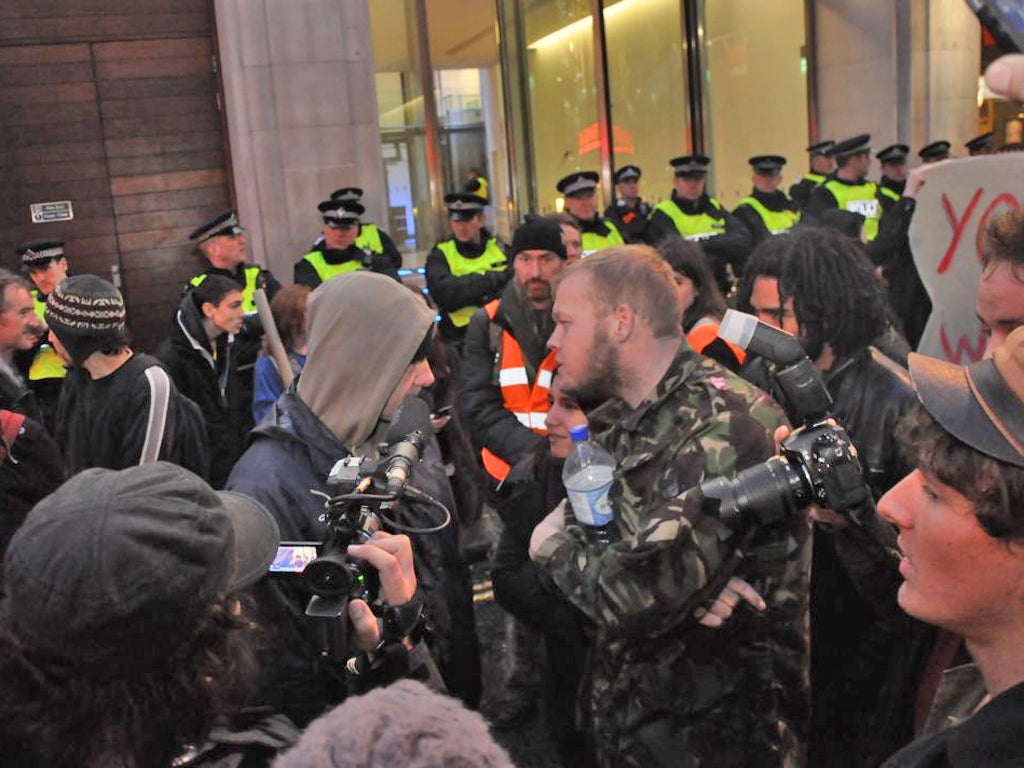The moment protesters found a plain-clothes cop in their midst
Campaigners complain of invasive policing tactics against Occupy movement in London

Usually, it is the police who kettle protesters. The tables were turned, though, when demonstrators unmasked and surrounded a plain-clothes officer who had infiltrated their midst during this week's public sector protests.
The hoodie-wearing interloper was discovered by protesters from the Occupy movement from St Paul's while they were attempting to take over a building near Piccadilly Circus in central London on Wednesday.
The incident, which occurred outside the offices of the mining company Xstrata, was captured on video by The Independent (above, left). Protesters asked the man whether he worked for the Metropolitan Police. He can be seen in the film nodding and answering: "Yeah, I'm a Met Police officer, yeah."
At that, one of the group said: "Right, let's circle him so he can't go anywhere." Protesters duly surrounded the officer, chanting "shame on you". Within moments the chants turned to "scum, scum, scum". One protester was heard to say: "He has no uniform and no [badge] number... we have no way of identifying him, so how are we supposed to complain about him."
The officer was allowed to reach the line of uniformed police who were kettling the protest, and they let him through. Protesters have complained recently about a perceived increase in the number of plain-clothes or undercover police officers at protest marches. Videos of people suspected of such a role have surfaced online, and cards with images of those thought to be police officers have reportedly been distributed among demonstrators.
A Metropolitan Police spokesman confirmed yesterday that plain-clothes officers were deployed "to observe and identify those people who were committing offences". He added: "When uniformed officers arrived on scene the plain-clothes officers were on hand to identify those who had committed crimes so they could make arrests."
"The deployment of plain-clothes officers is an effective tactic to tackle crime in many situations including public order events," the spokesman said. He confirmed that plain-clothes officers are trained to judge whether to reveal their identity if challenged by members of the public.
Protesters claimed to have unmasked seven men they believed to be plain-clothes officers – including the one in The Independent's video – as they were kettled on Wednesday afternoon.
Campaigners denounced the use of plain-clothes police as "underhand" and "utterly unwelcome," calling it "a form of deception, [which] runs utterly counter to principles of accountable policing".
A spokesman for the Defend the Right to Protest group said: "This underhand tactic is far more common than many people think."
Val Swain, of the Network for Police Monitoring, said: "Unlike uniformed police officers, those in plain clothes wear no identifying numbers, and cannot be held to account. The use of plain clothes police can cause an unpleasant level of distrust among demonstrators, even those who are law-abiding. Nobody wants to go on a demonstration where you are not sure whether the person next to you could be recording what you say for the police file. That is not the sort of society we want to live in.
"In addition, we have no information about the remit of plain-clothes police officers at demonstrations. What is the extent of their role?
"This is an invasive policing tactic that has no regard for civil liberties. Those engaged in protest already feel under siege from aggressive and disproportionate policing."
